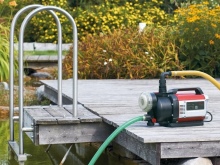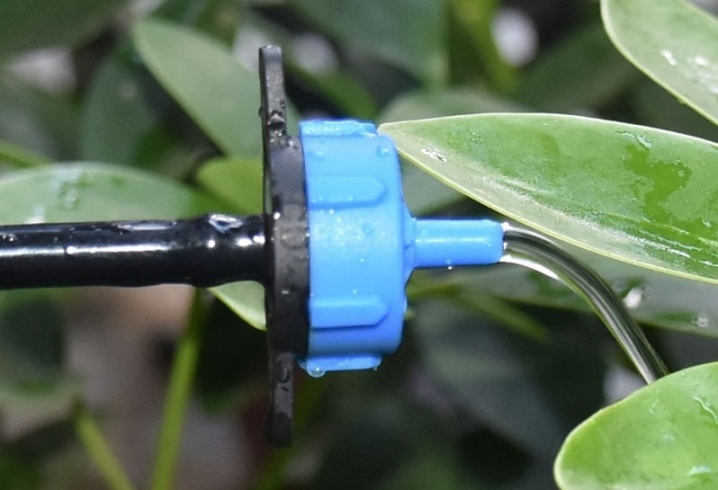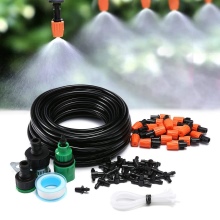What is drip irrigation and how to install it?

Today absolutely every owner of a backyard can organize drip irrigation on a plot - automatic or of another type. The simplest diagram of the irrigation system makes it clear how this method of supplying moisture works, and ready-made kits on sale provide quick and convenient installation of equipment. A detailed overview of all the options with a story about how to make watering for a summer residence with your own hands from plastic bottles will help you better understand how such an engineering solution is suitable for a particular site.

What is it and how is it arranged?
UPC or drip irrigation system is a popular option for organizing irrigation at a summer cottage today. Such utilities are laid in greenhouses and in open ground, used in the garden for trees and shrubs, and sometimes for home flowers and indoor plants. Local irrigation in the root zone works best for plantings that are not suitable for sprinkling methods. The principle of operation of the system is quite simple: water enters the branched irrigation system through thin tubes with holes, goes directly to the roots, and not to the leaves or fruits.
Initially, such equipment was developed in regions with a desert climate, where moisture is of a very high value, but it is easy to adapt it to almost any operating conditions.



The drip irrigation system, depending on its design, operates from a main water supply source (well, well) or a locally installed summer cottage reservoir. The main components that are in any set of such equipment are main hoses or tapes, as well as droppers for supplying moisture to plants.
Additional components, depending on the circuit and equipment device, can be as follows:
- pump;
- faucet for mechanical start-up of water;
- tee for branching highways;
- start-connector for a dedicated line;
- pressure regulator taking into account the water pressure (reducer);
- injector (sprinkler);
- controller / timer for automatic start of irrigation according to the schedule;
- counters for determining the consumption of moisture;
- float element to stop filling the tank at the desired level;
- filtration system;
- nodes for the introduction of fertilizing / concentrates.
There is no single correct option. Depending on what conditions for the organization of drip irrigation are on the site, the components are selected individually.



Description of species
Micro-drip irrigation of plants can be organized as an underground or surface system. It is suitable for open beds and greenhouses, flower gardens, vineyards, separately growing trees and shrubs. Water consumption in annual terms with drip irrigation is reduced by 20-30%, and it is possible to organize its supply even if there is no well or well in the reach.

An overview of all the available types of systems helps to understand which option is better.
- Machine. The power supply of such systems is usually carried out from a water supply system that receives moisture from a well or well, an option with an intermediate tank is possible. In this case, automatic watering will be carried out immediately with a liquid of a comfortable temperature, preventing root rot.The electronics will ensure the supply of moisture to the roots on a schedule, with the desired frequency and intensity. It is reasonable to equip autowatering in large areas, in greenhouses or in places with minimal precipitation.
- Semi-automatic. Such systems are able to independently turn on and off water on a schedule by setting a timer. But they only work from the storage tank. The liquid supply in it will have to be replenished on its own, usually a weekly renewal of resources is enough.
- Mechanical. Such systems work on the same principle as others. The only difference is that the water supply occurs exclusively by manually opening the tap or valve in the water tank. The liquid is supplied by gravity, without a pressure pump, the storage tank is installed at a certain height to ensure sufficient pressure in the line.



When using an additional reservoir, the temperature of the water for irrigation is more comfortable for the plants than when it comes directly from the well. In this case, it is better to organize the filling of the tank in such a way that the required water level is automatically maintained in the system. When it drops to a certain level, the float valve in the tank activates the pump to replenish the losses.

Popular sets
Ready-made sets of equipment for drip irrigation are on sale in a wide range. You can find options for connecting to the backbone and for autonomous systems, cheap and expensive modifications. When choosing, you need to look not only at the price, but also at the complete set. Additional tapes, fittings, automation elements can cost more than the basic set of equipment. The rating of UPCs presented on the market will help to understand the choice of a suitable solution.



"AquaDusya"
One of the most popular options. Manufactured in Belarus, there is a choice between sets with varying degrees of automation. Systems "AquaDusya" are inexpensive, focused on use in greenhouses and in the open field. Watering is carried out from a storage-type tank (not included in the kit), you can control the water level by starting its supply from the pump, set a convenient schedule and intensity of irrigation.
The equipment is designed to supply moisture to up to 100 plants at a time.


Gardena 01373
SKP for large greenhouses with main water supply. Capable of supplying moisture to 40 plants on an area of up to 24 m2. The kit already has everything you need, including a filter, it is possible to increase the number of droppers by connecting with other sets of the company.
You can configure the operation of the equipment yourself, launching and connecting take a minimum of time.


Aqua planet
This set is able to work with both a storage tank and a main water supply as a source of water supply. The kit includes an electronic timer with adjustable watering duration and frequency - from 1 hour to 1 time in 7 days.
The system was produced in the Russian Federation, designed for 60 plants and an area of up to 18 m2, it contains all the necessary components for connection.



"Signor Tomato"
Irrigation system for farms and large plots, work is carried out from solar storage batteries. The set features a high level of automation, there is a pump with pressure control, a set of flexible hoses, a control panel for selecting an operating mode with setting additional parameters, a built-in dispenser for liquid fertilizers.


Gardena 1265-20
The kit for the UPC from the reservoir is designed for 36 plants. There is an adjustment of water consumption in the range of 15-60 l / min, a pump with memory for saving precise settings, a timer. The system works in automatic mode, it is more expensive than analogs, but it is reliable and functional.



Grinda
Watering system from a container, designed to provide moisture up to 30 plants at once. Maximum water consumption - 120 l / h, complete with a 9 m hose, droppers, fasteners for fixing in the ground, a filter, a set of fittings. The trunk is easy to mount and connect by yourself.



"Bug"
SKP for 30 or 60 plants, depending on the configuration. This budget model is presented in options for connecting to a tank or main water supply (in this case, it is supplemented with a filter and an electronic timer). When working by gravity, the connection to the barrel is carried out through a special fitting.



Not all UPCs on sale are cheap. The high level of automation comes at a price. But using such systems is much more pleasant and comfortable than simple models that do not even have a timer.


Installation features
It is quite possible to connect the drip irrigation system yourself. It is enough to follow the instructions supplied by the manufacturer. The rules common to all systems are as follows.
- Pre-planning. At this stage, the place of equipment installation, the number of lines, and their length are calculated.
- Installation of containers for irrigation. If you do not use a direct supply of liquid from the plumbing system, you will have to equip a tank of sufficient capacity, cut a valve into it to control the supply of moisture.
- Installing the controller. It is necessary in automated systems, allows you to program the intensity, frequency of irrigation.
- Installation of a pump or reducer to control the water pressure.
- Installation of a filtration system. It is necessary in order to ensure that only clean water is supplied to the droppers, without large impurities and debris.
- Drip tape laying. It is produced by the surface method or with a depth of 3-5 cm. In addition, separate dropper-dispensers are supplied to each plant.
- Summing up the highways. Tapes are connected to them through embedded start connectors. Their number is calculated based on the number of tapes.
- Test run. At this stage, the system is flushed, after which the edges of the ribbons are tied or closed with plugs. Without this precaution, debris will enter the irrigation pipes.



In many cases, a modified system is deployed on the basis of one set of equipment, which is gradually modernized and improved. If plants with different moisture requirements are to be watered, the easiest way is to install several separate modules. So each type of planting will receive the right amount of water without waterlogging the soil.
When supplying water from a pond or other natural source, it is imperative to install a multi-stage filter. To avoid pressure drops in autonomous irrigation systems, you should not save on the reducer either.
The installation of an additional valve for flushing the pipes will help to facilitate the preparation of equipment for the winter. It is mounted at the end of the main pipe.



How to do it yourself?
The simplest automatic irrigation system for a summer residence can be created with your own hands with practically no cost from improvised means. You only need a container and a set of tubes or tapes. For a large garden, where several crops are to be watered in the open field at once, water supply from a home highway may be a preferable option. The simplest engineering solutions are worth considering separately.

From a greenhouse barrel
A small drip irrigation system can be installed inside a local facility for heat-loving plants. In this case, the barrel is raised to a height of 0.5 to 3 meters - so that the pressure is sufficient for the gravity flow of moisture with the required frequency and intensity.
The system is created like this.
- The main water supply line is mounted from the barrel. The presence of a filter is required.
- Branch pipes are connected to it through connectors. Metal-plastic or PVC will do.
- Holes are made in the hoses. A separate dropper is inserted into each for each plant.
After starting the system, water will gradually be supplied from the barrel under pressure, flowing through tubes and droppers to the roots of the plants. If the height of the greenhouse is not enough to create the required pressure, the problem is solved by installing a submersible pump. In a large greenhouse, it is advisable to install a storage tank for several tons of water, fixing it on the outside on steel supports. Such a system is equipped with automation elements - a timer, a controller.
When watering from a barrel, not electronic, but mechanical equipment with a daily supply of the plant is used.



From plastic bottles
It is quite possible to water individual plants by adapting individual reservoirs for their drip irrigation. Large plastic bottles of 5 liters are ideal for this purpose. The easiest way to make a submersible irrigation system.
- 3-5 holes are made in the lid of the tank with an awl or a hot nail or drill.
- The bottom is partially cut off. It is important that debris does not get inside and that water is easy to top up.
- The bottle is dug into the ground with the neck down. The holes are pre-wrapped with nylon or other cloth in several layers so that they are not clogged with soil. It is best to do this before planting the plants so as not to damage the root system of the seedlings.
- Water is poured into the container. Its reserves will have to be replenished as it is spent.
You can also drip in the bottle with the neck up. In this case, holes are made in the bottom, up to 10 pieces. Immersion in the ground is carried out by deepening the container a little more. This irrigation method is very much in demand when growing garden crops in tall wooden beds with sides.
You can also hang the bottle by pulling the drip tube from it to the roots - here it will be important to constantly maintain a good water pressure.



Typical mistakes
The organization of the drip irrigation system looks quite simple, but not everyone succeeds in realizing this idea without errors. Among the most common problems faced by owners of plots with local irrigation are the following.
- Incorrect dropper distribution. They may be too close or too far apart. As a result, the water will not reach part of the territory in the required volume, the plants will begin to dry. With excessive thickening of droppers, waterlogging of the territory is observed, the beds are literally drowning in water, the roots begin to rot.
- Incorrect system pressure adjustment. If it is too low, the plants will receive less moisture than calculated. If the pressure is too high, the system can stop working, especially with automation or low flow rates. When using ready-made irrigation devices, it is imperative to follow the manufacturer's recommendations specified in the accompanying documentation.
- Mixed landings. If plants with different requirements for the amount of moisture are located on the same irrigation line, it will not work normally to adjust the system. Shoots will receive less water or die from its excess. When planning plantings, it is better to place them zonally, combining those species that require approximately the same watering intensity.
- Miscalculations in the required water supplies. This usually happens when the drip irrigation system is inserted into the general water supply line at the site. If the system is not tested in advance, there is a great risk that the incoming moisture will not be enough. Similar problems arise with tanks that need to be manually filled. In extreme heat, the water can easily run out in the tank earlier than planned, and the system will have nowhere to replenish its reserves.
- Excessive deepening of underground systems. When submerged to the level of root growth, drip tubes can gradually become clogged with shoots of the underground part of the plantings, collapse under their influence.The problem is solved only by minimal deepening - no more than 2-3 cm. In this case, the risks will be minimal.
- Poor water treatment. Even the most advanced filters do not completely protect the droppers from contamination. When choosing a cleaning system, you need to focus on a particle diameter smaller than the size of the narrowest point in the irrigation system. The stock should be at least three times in order to accurately avoid blockages in the droppers and the ingress of debris.
- Belt damage and misalignment. This problem is relevant in areas with surface irrigation systems. They are of great interest to birds, and in regions with strong winds and heavy rainfall, they are often simply carried away during bad weather. In the first case, the problem is solved by installing scarers that stop the visits of feathered guests. Taking this point into account when designing helps to avoid flushing and demolition of tubes or tapes - in regions with difficult climates, the best solution is buried dropper options.
These are the main difficulties and mistakes that can be encountered when organizing autonomous root watering on a site. They should be taken into account if the installation will be carried out independently.

Review overview
Drip irrigation systems have become popular not only among professional agronomists. Reviews of gardeners and truck farmers who have already tested such equipment on their plots fully confirm this.
- According to most buyers, ready-made drip irrigation systems make it much easier to care for plants on the site. Even semi-automatic equipment options allow solving problems of providing plants with moisture for the entire season. With automatic watering, you can even go on vacation or forget about summer cottage problems for a week or two.
- Gardeners like the affordable price of most kits. The most budgetary options require no more than 1,000 rubles of initial investment. In this case, you can organize watering from a barrel or connect to a water supply system from a well.
- The large number of available options is another obvious plus of such systems. They are also praised for the ease of installation, even a person without technical education and special skills can cope with the assembly of the system.
Buyers also speak quite frankly about the shortcomings. For example, some battery-powered starters consume 12 batteries at once, and not cheap salt ones, but more expensive and modern ones. Such accompanying expenses are not to everyone's liking. There are also complaints about the quality of the pipes - most summer residents change them to more practical ribbons after 1-2 seasons.














The comment was sent successfully.